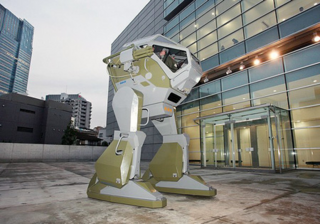Related Research Articles

A robot is a machine—especially one programmable by a computer—capable of carrying out a complex series of actions automatically. A robot can be guided by an external control device, or the control may be embedded within. Robots may be constructed to evoke human form, but most robots are task-performing machines, designed with an emphasis on stark functionality, rather than expressive aesthetics.

Telerobotics is the area of robotics concerned with the control of semi-autonomous robots from a distance, chiefly using television, wireless networks or tethered connections. It is a combination of two major subfields, which are teleoperation and telepresence.

A robotic telescope is an astronomical telescope and detector system that makes observations without the intervention of a human. In astronomical disciplines, a telescope qualifies as robotic if it makes those observations without being operated by a human, even if a human has to initiate the observations at the beginning of the night or end them in the morning. It may have software agents using artificial intelligence that assist in various ways such as automatic scheduling. A robotic telescope is distinct from a remote telescope, though an instrument can be both robotic and remote.

The Land Walker is the first 3.4-meter-tall (11 ft) bipedal robot. Despite its name, it does not actually walk— instead shuffling on wheels hidden under its "feet" at approximately 1.5 km/h (1 mph). It was invented by Masaaki Nagumo and created by researchers who hope to someday create similar robots to be used in the military and law enforcement.

An unmanned ground vehicle (UGV) is a vehicle that operates while in contact with the ground and without an onboard human presence. UGVs can be used for many applications where it may be inconvenient, dangerous, or impossible to have a human operator present. Generally, the vehicle will have a set of sensors to observe the environment, and will either autonomously make decisions about its behavior or pass the information to a human operator at a different location who will control the vehicle through teleoperation.

Thunderbirds 2086 is the English dubbed version of the Japanese anime series Scientific Rescue Team Technoboyger, loosely inspired by the original Gerry Anderson Supermarionation series Thunderbirds. The English dub was produced by ITC Entertainment, the original production company for Thunderbirds, although it is not officially recognized as canon because Gerry Anderson and Sylvia Anderson were not involved.

A robot competition is an event where the abilities and characteristics of robots may be tested and assessed. Usually they have to beat other robots in order to become the best one. Many competitions are for schools but several competitions with professional and hobbyist participants are also arising.

In Japan, popular robots include humanoid entertainment robots, androids, animal robots, social robots, guard robots, and many more. Each type has a variety of characteristics.

Disaster: Day of Crisis is a 2008 action-adventure light gun shooter developed by Monolith Soft and published by Nintendo for the Wii. In it, the player must survive various natural disasters while also battling terrorists and rescuing civilians. According to Nintendo, the game features “cutting-edge physics and gripping visuals” to recreate the sheer terror of major catastrophes.

A jack is a mechanical lifting device used to apply great forces or lift heavy loads. A mechanical jack employs a screw thread for lifting heavy equipment. A hydraulic jack uses hydraulic power. The most common form is a car jack, floor jack or garage jack, which lifts vehicles so that maintenance can be performed. Jacks are usually rated for a maximum lifting capacity. Industrial jacks can be rated for many tons of load.

A rescue robot is a robot designed to aid in the search and rescue of humans. They may assist rescue efforts by searching, mapping, removing rubble, delivering supplies, providing medical treatment or evacuating casualties.
The Thunderbirds machines are a series of vehicles that were imagined for the mid-1960s film and television series called Thunderbirds, which was developed by Gerry and Sylvia Anderson. The series began with the Supermarionation television show Thunderbirds and was followed by the subsequent feature films Thunderbirds Are Go and Thunderbird 6, which were released between 1965-68. The show featured a large variety of futuristic air, land, and sea vehicles and machines, most of which were designed by special effects director Derek Meddings.

Airborne Real-time Cueing Hyperspectral Enhanced Reconnaissance, also known by the acronym ARCHER, is an aerial imaging system that produces ground images far more detailed than plain sight or ordinary aerial photography can. It is the most sophisticated unclassified hyperspectral imaging system available, according to U.S. Government officials. ARCHER can automatically scan detailed imaging for a given signature of the object being sought, for abnormalities in the surrounding area, or for changes from previous recorded spectral signatures.

Mesa Associates' Tactical Integrated Light-Force Deployment Assembly (MATILDA) is a remote controlled surveillance and reconnaissance robot created and designed by the Mesa Robotics Corporation. It is available in many different models such as the Urban Warrior, Block II, and Scout, which feature different combinations of components for increased utility. These options include a sensor mount, manipulator arm, weapon mount, fiber optic reel, remote trailer release, and disrupter mount. When purchased the basic system includes the platform, the control unit, and battery charger.
Tomotaka Takahashi is a Japanese roboticist and founder of Kyoto University's ROBO-GARAGE since 2018. Takahashi creates humanoid robots known for their smooth, fluid motions and sleek appearance. Having built many humanoid robots entirely by himself, from simple concepts to production, Takahashi's designs have been featured in several art exhibitions celebrating the creation of Astroboy, Time Magazine's Coolest Inventions of 2004, and promotions for Bandai, Panasonic, and Pepsi. He has also worked with toy companies to produce relatively inexpensive robots for the hobby market, including those for Kyosho.
The Crevalcore train crash was a major railway accident which occurred on 7 January 2005 on the Verona–Bologna railway, Italy, killing 17. It was one of the worst accidents in the recent history of the state railway company Ferrovie dello Stato. In the accident, a cargo and a passenger train collided in dense fog after the passenger train's driver passed two red signals, possibly as a result of an unwarranted assumption by the driver that the line was clear, despite the warning signals.

The DRDO Netra is an Indian, light-weight, autonomous UAV for surveillance and reconnaissance operations. It has been jointly developed by the Research and Development Establishment (R&DE), and IdeaForge, a Mumbai-based private firm.
E.M.I.L.Y. is a robotic device used by lifeguards for rescuing swimmers. Created by Hydronalix, a maritime robotic company, and funded by the United States Navy, EMILY operates on battery power and is operated by remote control after being dropped into the water from shore, a boat, pier, or helicopter. Using an impeller motor to travel through water, it is able to reach victims much faster than a human lifeguard can by swimming, and it is more compact and less expensive to maintain than crewed watercraft. It can also operate in weather and surf conditions that make other rescue attempts impractical. Once it reaches the victims its foam core allows it to function as a flotation device for four to six people holding onto side ropes or handles.

Kuratas is a rideable and user-operated mecha built by the Japanese company Suidobashi Heavy Industry. Billed as "the world's first giant boarding robot", the Kuratas was unveiled when the website was opened in 2012. It was demonstrated at Wonder Festival. In June 2015, MegaBots challenged Suidobashi Heavy Industry to its first robot duel confronting Kuratas versus their Mark II.
T52 may refer to:
References
- 1 2 3 4 5 6 Fujita, Shiro. "Rescue Robot "T-52 Enryu"" (PDF). www.iaarc.org. Retrieved 28 October 2014.
- ↑ "Enryu.jp" レスキューロボット 「援竜」豪雪地帯で初の雪害対策実験:報告 (in Japanese). Tmsuk. 2006-02-06. Retrieved 2009-01-25.
- 1 2 Noel, Audrey. "T-52 Enryu". prezi.com. Prezi. Retrieved 11 November 2014.
- ↑ Tmsuk. "Company Profile". www.tmsuk.co.jp. Retrieved 29 October 2014.
- ↑ Megalingam, Rajesh Kannan. "Kinect Based Humanoid for Rescue Operations in Disaster Hit Areas" (PDF). gimt.edu.in. Retrieved 29 October 2014.
- ↑ BotJunkie. "Tmsuk Enryu, Japan's six-ton robotic version of our jaws of life". www.device.com. Device.com. Retrieved 10 November 2014.